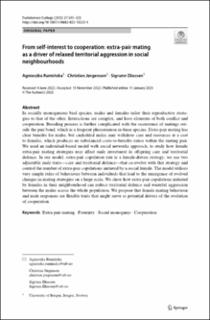| dc.contributor.author | Ruminska, Agnieszka | |
| dc.contributor.author | Jørgensen, Christian | |
| dc.contributor.author | Eliassen, Sigrunn | |
| dc.date.accessioned | 2023-08-10T12:50:40Z | |
| dc.date.available | 2023-08-10T12:50:40Z | |
| dc.date.created | 2023-04-13T10:52:20Z | |
| dc.date.issued | 2023 | |
| dc.identifier.issn | 0269-7653 | |
| dc.identifier.uri | https://hdl.handle.net/11250/3083392 | |
| dc.description.abstract | In socially monogamous bird species, males and females tailor their reproductive strategies to that of the other. Interactions are complex, and have elements of both conflict and cooperation. Breeding process is further complicated with the occurrence of matings outside the pair bond, which is a frequent phenomenon in these species. Extra-pair mating has clear benefits for males, but cuckolded males may withdraw care and resources at a cost to females, which produces an unbalanced costs-to-benefits ratios within the mating pair. We used an individual-based model with social networks approach, to study how female extra-pair mating strategies may affect male investment in offspring care and territorial defence. In our model, extra-pair copulation rate is a female-driven strategy; we use two adjustable male traits—care and territorial defence—that co-evolve with that strategy and control the number of extra-pair copulations initiated by a social female. The model utilises very simple rules of behaviours between individuals that lead to the emergence of evolved changes in mating strategies on a large scale. We show how extra-pair copulations initiated by females in their neighbourhood can reduce territorial defence and wasteful aggression between the males across the whole population. We propose that female mating behaviour and male responses are flexible traits that might serve as potential drivers of the evolution of cooperation. | en_US |
| dc.language.iso | eng | en_US |
| dc.publisher | Springer | en_US |
| dc.rights | Navngivelse 4.0 Internasjonal | * |
| dc.rights.uri | http://creativecommons.org/licenses/by/4.0/deed.no | * |
| dc.title | From self-interest to cooperation: extra-pair mating as a driver of relaxed territorial aggression in social neighbourhoods | en_US |
| dc.type | Journal article | en_US |
| dc.type | Peer reviewed | en_US |
| dc.description.version | publishedVersion | en_US |
| dc.rights.holder | Copyright 2023 The Author(s) | en_US |
| cristin.ispublished | true | |
| cristin.fulltext | original | |
| cristin.qualitycode | 1 | |
| dc.identifier.doi | 10.1007/s10682-022-10222-4 | |
| dc.identifier.cristin | 2140517 | |
| dc.source.journal | Evolutionary Ecology | en_US |
| dc.source.pagenumber | 305-325 | en_US |
| dc.identifier.citation | Evolutionary Ecology. 2023, 37 (2), 305-325. | en_US |
| dc.source.volume | 37 | en_US |
| dc.source.issue | 2 | en_US |

